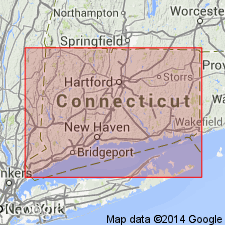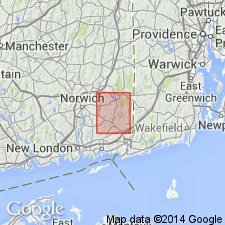
- Usage in publication:
-
- Preston gabbro diorite
- Modifications:
-
- Named
- Dominant lithology:
-
- Gabbro
- Diorite
- AAPG geologic province:
-
- New England province
Summary:
Named the Preston gabbro diorite in eastern CT for Preston Township, New London Co. Consists of dark-colored rock which shows a number of variations and follows a definite gradation from center of mass towards the periphery; includes coarse porphyritic gabbro, diorite, and quartz diorite. Intruded before the metamorphism that reconstructed the rocks of the entire State. The Preston is of Carboniferous or post-Carboniferous age.
Source: GNU records (USGS DDS-6; Reston GNULEX).

- Usage in publication:
-
- Preston gabbro*
- Modifications:
-
- Revised
- AAPG geologic province:
-
- New England province
Summary:
Revised to Preston gabbro. Mapped and described as two facies; a coarse porphyritic gabbro with large poikilitic phenocrysts of diallage, and a quartz-hornblende gabbro. The Preston is older than the Sterling granite gneiss and intrudes sedimentary rocks of Cambrian and Carboniferous age.
Source: GNU records (USGS DDS-6; Reston GNULEX).
For more information, please contact Nancy Stamm, Geologic Names Committee Secretary.
Asterisk (*) indicates published by U.S. Geological Survey authors.
"No current usage" (†) implies that a name has been abandoned or has fallen into disuse. Former usage and, if known, replacement name given in parentheses ( ).
Slash (/) indicates name conflicts with nomenclatural guidelines (CSN, 1933; ACSN, 1961, 1970; NACSN, 1983, 2005, 2021). May be explained within brackets ([ ]).

